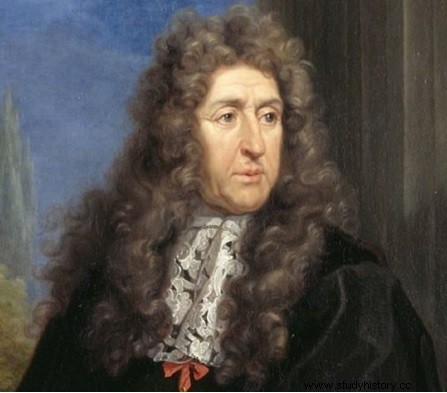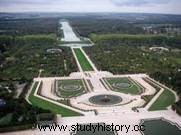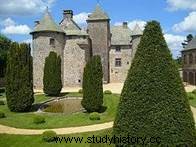 André Le Nôtre (1613-1700) is a famous French gardener and landscaper, inventor of a style of garden called "French garden". Appointed gardener to King Louis XIV in 1645, André Le Nôtre designed the garden of the Château de Vaux-le-Vicomte with Louis Le Vau, the architect of this building. His greatest work is the creation of the garden of the Palace of Versailles. This gigantic project occupied him for more than 30 years. His style, which combines rigor and harmony, influenced many landscape painters throughout Europe during the 17th century.
André Le Nôtre (1613-1700) is a famous French gardener and landscaper, inventor of a style of garden called "French garden". Appointed gardener to King Louis XIV in 1645, André Le Nôtre designed the garden of the Château de Vaux-le-Vicomte with Louis Le Vau, the architect of this building. His greatest work is the creation of the garden of the Palace of Versailles. This gigantic project occupied him for more than 30 years. His style, which combines rigor and harmony, influenced many landscape painters throughout Europe during the 17th century.
Le Nôtre, gardener from father to son
André Le Nôtre was born on March 12, 1613 in the Tuileries, into a family of gardeners:his grandfather was a gardener to Catherine de Medici; his father titled "draughtsman of plants and gardens" and "gardener to the king at the Tuileries". André therefore naturally spent his youth in the Bord de l'eau gallery at the Louvre, then took courses in architecture with François Mansart as well as those in painting in the studio of Simon Vouet, meeting Le Brun and Mignard. Always wanting to learn, he learns agronomy, hydrology, mathematics and already achieves elevation changes in stages. From the 1630s, Le Nôtre worked in the garden under the orders of his father and Claude Ier Mollet before obtaining in 1637 the patent of gardener of the Tuileries then in 1643 the position of "draughtsman of the plans and parterres of all the Gardens of His Majesty", but he will never bear the title of "First Gardener of the King".
In 1640 he married Françoise Langlois, daughter of an ordinary commissioner of the artillery of France; their three children die in infancy. However, the tradition continues since two of André's three sisters will marry gardeners.
In the meantime, at the age of 22, he became First Gardener to Monsieur, taking care of the Tuileries gardens, those of Luxembourg, the Palais Royal and Fontainebleau at the same time. He was noticed by Fouquet who attracted him to Vaux le Vicomte, while acquiring the post of Comptroller General of the Buildings and Gardens of the King in 1657, still staying at the Tuileries and still maintaining the gardens. Due to his function, he must be able to supervise the most diverse works in terms of locksmithing, sculpture, masonry and control the memories of contractors with a view to their payment by the general treasurers.
His design of the gardens
 It now sets the rules for so-called "French" gardens, by transforming marshy land into magnificent gardens, in airy spaces offering a distant perspective, contrary to the use of the Renaissance which wanted enclosed gardens, with an alternation of light and shade, a mixture of marble sculptures and plants. Using a limited number of simple geometric shapes made of circles, squares, rectangles, hexagons, octagons, sometimes combined, he associates very ornate parts near the dwellings with other more refined ones.
It now sets the rules for so-called "French" gardens, by transforming marshy land into magnificent gardens, in airy spaces offering a distant perspective, contrary to the use of the Renaissance which wanted enclosed gardens, with an alternation of light and shade, a mixture of marble sculptures and plants. Using a limited number of simple geometric shapes made of circles, squares, rectangles, hexagons, octagons, sometimes combined, he associates very ornate parts near the dwellings with other more refined ones.
The terraces are open to the landscape composed of refined flowerbeds, groves, as far as the eye can see, as in Saint Germain en Laye where the terrace overlooks the Seine but offers a view of Paris or like the perspective at the end of the Tuileries gardens, believing that "the Tuileries lead to nothing but a nasty path" thus creating the future Champs Elysées!
André Le Nôtre, Gardener to the Kings
Louis XIV hearing only good things about this man, called him in 1661 to take care of the gardens of Versailles. Le Nôtre is surprised to see a large marsh in front of the castle, but he has a solution “Pardi! We are going to turn it into a grand canal! ". His painting lessons as well as the knowledge of Le Brun and Mignard served him well; it enhances the terrain, creating perspectives where the size of the trees lengthens as one moves away from the castle.
From then on, the greats of the kingdom asked for it:Monsieur at Saint Cloud, Colbert at Sceaux, Madame de Montespan at Clagny; he worked on the sites of Trianon, Maintenon, Saint-Cyr, Marly, Chantilly, Paris, as well as in several mansions in Saint-Maur, Saint-Martin de Pontoise, Chaville, Louvois, Pontchartrain and Conflans.
 In Europe, Charles II of England called on him for the gardens of Greenwich, Hampton Court and Windsor; Le Nôtre's name is associated with the Charlottenburg garden in Berlin; the royal gardens of Drottningholm in Sweden resemble the pools of Chantilly; in Russia, the gardens of Peterhof in Saint Petersburg are embellished with waterfalls, fountains and pavilions reminiscent of the splendor of the great French gardens; in Spain, we find “his paw” in the gardens of La Granja near Segovia…Even the Pope asks him to redo his gardens! Ours is loved everywhere.
In Europe, Charles II of England called on him for the gardens of Greenwich, Hampton Court and Windsor; Le Nôtre's name is associated with the Charlottenburg garden in Berlin; the royal gardens of Drottningholm in Sweden resemble the pools of Chantilly; in Russia, the gardens of Peterhof in Saint Petersburg are embellished with waterfalls, fountains and pavilions reminiscent of the splendor of the great French gardens; in Spain, we find “his paw” in the gardens of La Granja near Segovia…Even the Pope asks him to redo his gardens! Ours is loved everywhere.
André Le Nôtre was a subtle courtier, staying away from court intrigues, but knowing how to curry favor with the king, so much so that he was the only one to kiss Louis XIV during a walk, to stand up to him or to place his chair next to that of the king in the gardens. Knighted in 1675, he composed his coat of arms with "three snails crowned with a stalk of cabbage, with a spade and a rake". In 1693, the king made him a Knight of the Royal Order of Saint-Michel, a rare distinction reserved for writers and artists.
For thirty years, he thus shared the intimacy of the king, to such an extent that the young Louis XIV considered him almost as his father… To thank the monarch and express his gratitude to him , Le Nôtre offered him approximately seventy paintings, bronzes as well as porcelains taken from his collection which he had been building since 1650, a great collector he owned prints, paintings of Italian, Dutch and Flemish paintings, sculptures, porcelains and especially a large number of modern medals.
The Greats pay homage to him
Very attached to his house near the Marsan pavilion, he retired there from 1694 and died on September 15, 1700 at the age of 87.
The Mercure Galant comments on his death in these glowing terms:"Le Roy has just lost a rare man, &zealous for his service, &very singular in his art, &who did honor. It is Mr. Le Nostre, Comptroller General of His Majesty's Buildings, Gardens, Arts and Manufactures of France. (...) No man has ever known better than him all that can contribute to the beauty of Gardens..."
 Saint Simon is not to be outdone and gives his eulogy "illustrious for having been the first to give the various drawings of those beautiful gardens which decorate France, and which have so effaced the reputation of those of Italy, that the most famous masters of this kind come from Italy to learn and admire here. Le Nôtre had a probity, an exactness, and a straightforwardness which made him esteemed and loved by everyone. He never left his state or misunderstood himself, and was always perfectly disinterested.
Saint Simon is not to be outdone and gives his eulogy "illustrious for having been the first to give the various drawings of those beautiful gardens which decorate France, and which have so effaced the reputation of those of Italy, that the most famous masters of this kind come from Italy to learn and admire here. Le Nôtre had a probity, an exactness, and a straightforwardness which made him esteemed and loved by everyone. He never left his state or misunderstood himself, and was always perfectly disinterested.
He worked for individuals as for the king, to reduce the true beauty to the expense he could…a month before his death, the king, who loved to to see and make him talk, took him to his gardens, and because of his great age, made him put in a chair that porters rolled next to his and Le Nôtre said “ah! my poor father, if you lived and could see a poor gardener like me, your son, strolling in a chair next to the greatest king in the world, nothing would be wanting to my joy”.
His portrait has stood for four centuries in the Gardeners' Building near the Orangery. On the main table, we discover the "general plan of the garden" dating from 1720 requested by Louis XV, a plan which has always served as a reference for gardeners since 1992, in order to restore the park to its original state.
Considered today as the first modern landscape painter, his contemporaries always rely on his work, to use all the qualities of a site:the relief, the views, the orientation, water, substrate in order to achieve a beautiful composition. As a result, in July 2013, the “Prix International André Le Nôtre” will be awarded for the first time to a landscape designer for all of his work!
Bibliography
-Portrait of a Happy Man:André Le Nôtre, 1613-1700, by Erik Orsenna. Folio, 2012.
- André le notre, by Patricia Bouchenot-Déchin. Fayard, April 2013.
